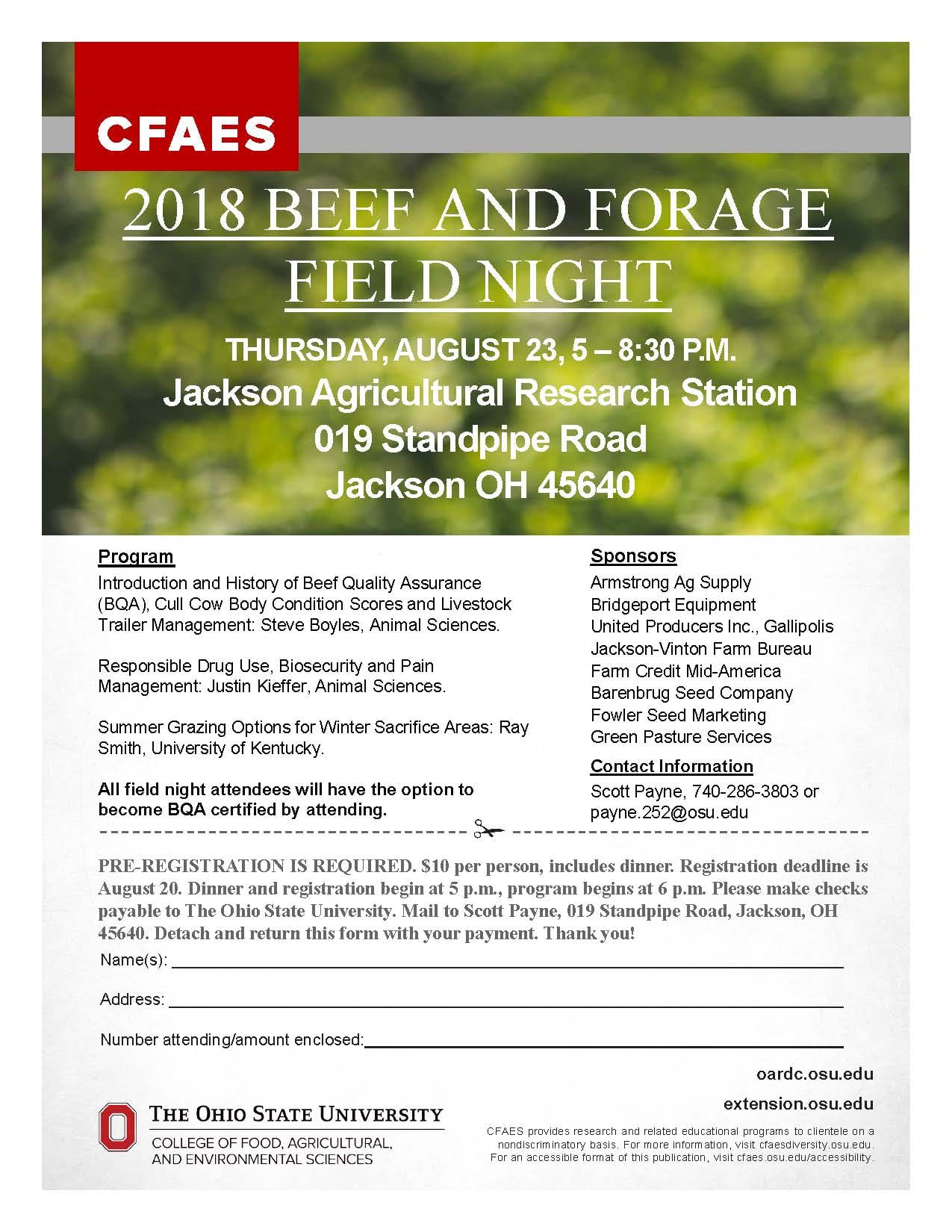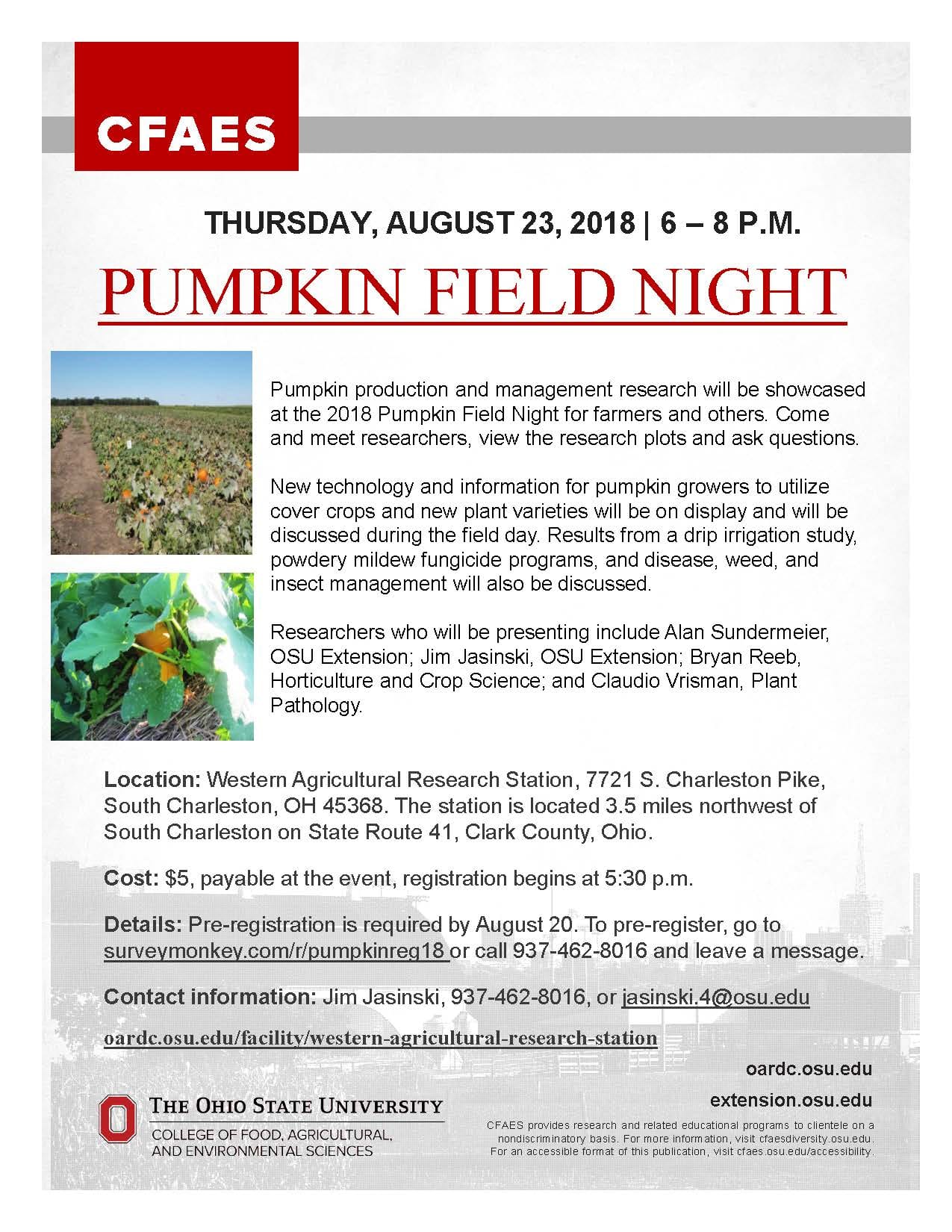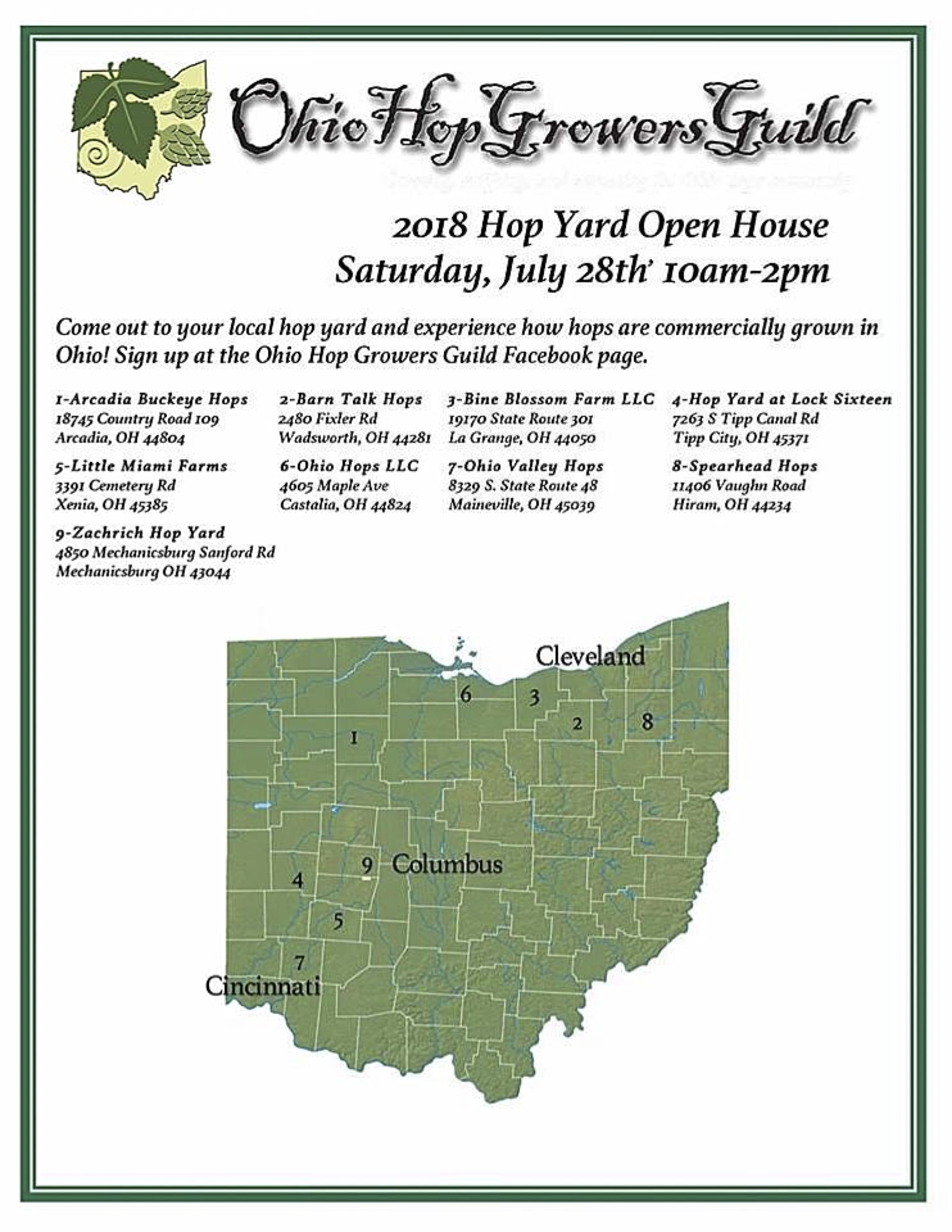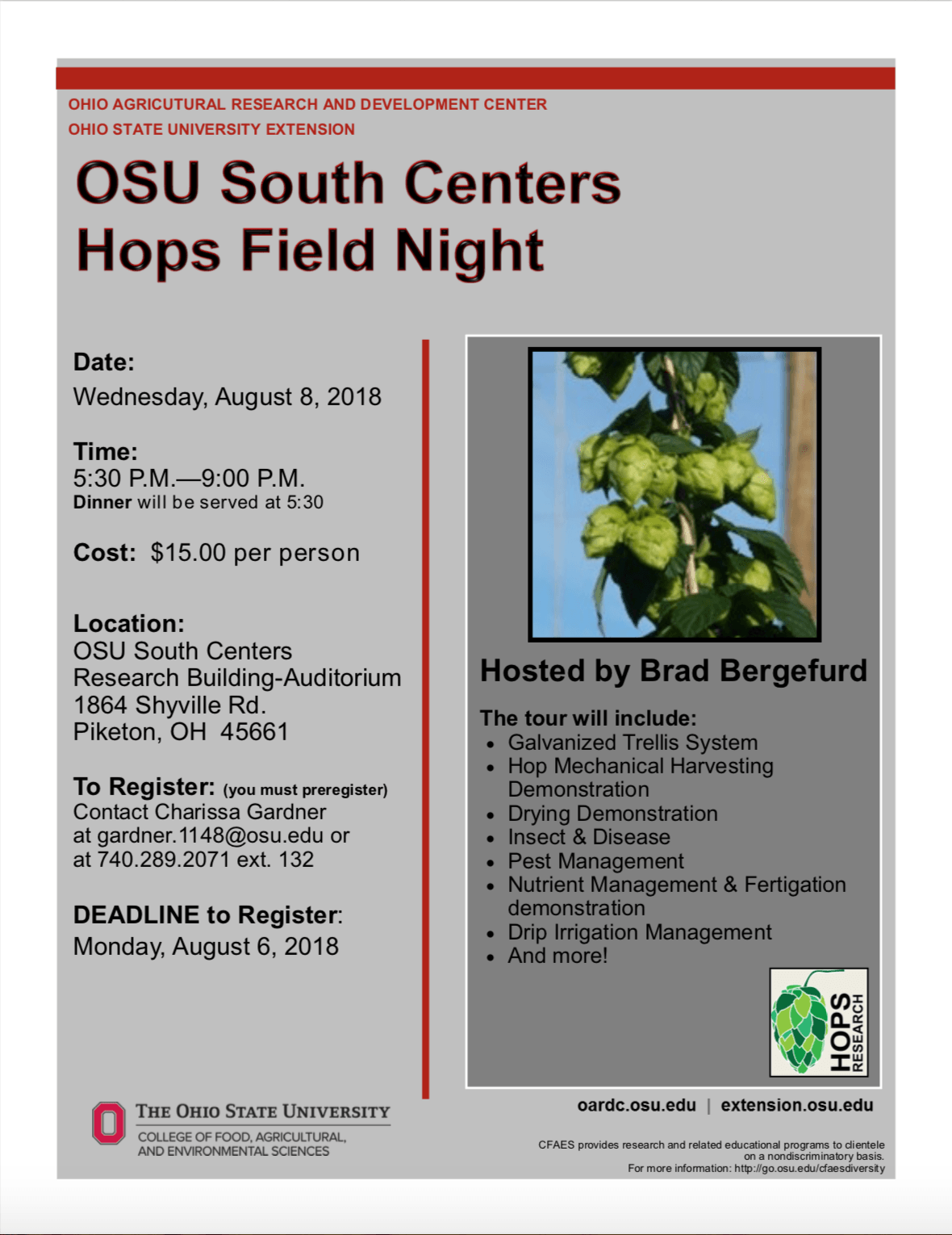The Extension Office will be closed on Tuesday, July 31 so that the staff can attend the funeral of Dawna Jo our former SNAP-ED program assistant.
Month: July 2018
2018 Beef and Forage Field Night
Upcoming Beef Quality Assurance Certification Trainings
By Brooke Beam, PhD
Ohio State University Extension, Highland County
Agriculture and Natural Resources/Community Development Extension Educator
July 24, 2018
While the vast majority of American citizens are disconnected from production agriculture, a cultural movement over the last decade has urged consumers to be more interested in their food and how it was produced. This interest in food and agricultural production has coincided with the introduction of the Millennial generation into the consumer market. Millennials differ from previous generations, as they are expected to be the “largest consumer spenders in history” and they are known as trendsetters in the agricultural marketplace (B. D. Johnson, 2016, p. 1).
Millennials want to live healthy lifestyles, and they are influencing not only their generation’s eating habits but also their children’s and parents’ eating trends (G. Johnson, 2016b). Scott Muchkin, a food trends researcher at Wolfe Research in New York, stated that the best advice farmers could follow was to have transparency in their farming operations (G. Johnson, 2016a). Munhkin stated modern consumers want to know everything about how their food was produced. Companies like Tyson Foods and Wendy’s have listened to the demands of the consumer and are setting goals to achieve transparency and high standards of beef production.
Tyson Foods harvests and processed “25 percent of the US beef market share” (OSU Extension Beef Team, 2018, p. 1). Wendy’s is “now the second largest fast food hamburger chain in the U.S.” (OSU Extension Beef Team, 2018, p. 1). Both corporations announced that beginning in 2019, all “cattle they purchase must originate from producers and feedyards who are Beef Quality Assurance certified” (OSU Extension Beef Team, 2018, p. 1).
The Ohio State University Extension Offices in Adams, Brown, Clermont, and Highland Counties will be offering Beef Quality Assurance (BQA) certification trainings for area beef producers along with local sale barns and veterinarians. These BQA certification trainings will allow for cattle to be sold to companies, like Tyson and Wendy’s, that will require BQA certification in 2019.
Four BQA certification trainings will be offered in Hillsboro, Ohio. Dates and locations of the upcoming BQA certification trainings are:
- Tuesday, August 14, 2018, Noon, Union Stockyards, Hillsboro
- Tuesday, August 28, 2018, 6:30 P.M., Union Stockyards, Hillsboro
- Thursday, September 13, 2018, 6:30 P.M., Producers Stockyards, Hillsboro
- Thursday, October 25, 2018, 6:30 P.M., Producers Stockyards, Hillsboro
Call your local Ohio State University Extension Office to register for the date and location of the BQA training of your choice. The Highland County Extension Office can be reached at 937-393-1918.
References
Johnson, B. D. (2016, June 9). Future Food: What Will It Be? Retrieved April 16, 2017, from Successful Farming: http://www.agriculture.com/farm-management/future food-what-will-it-be
Johnson, G. (2016a, February). Food Trends: Consumers Want Healthy, Local Foods. Successful Farming.
Johnson, G. (2016b, February 19). Meet Your New Boss: The Millennials. Successful Farming.
OSU Extension Beef Team. (2018). Beef Quality Assurance. Beef Team Blog. Retrieved from https://u.osu.edu/beefteam/bqa/
Upcoming Events:
Ohio Hop Growers Guild 2018 Hop Yard Open House will be held on Saturday, July 28, 2018, from 10:00 A.M. to 2:00 P.M. The public is welcome to attend and experience how hops are commercially grown in Ohio. Sign up at the Ohio Hop Growers Guild Facebook page. Three regional hop yards will be participating:
Scott Hop Farms
9681 U.S. Route 68
Georgetown, Ohio 45121
http://www.scottfarmsohio.com/hops.html
Little Miami Farms
3391 Cemetery Road
Xenia, Ohio 45385
Ohio Valley Hops
8329 S. State Route 48
Maineville, Ohio 45039
The Ohio State University will be hosting the Hops Field Night at the South Centers in Piketon on August 8, 2018, from 5:30 P.M. to 9:00 P.M. The cost is $15 per person and dinner will be served at 5:30 P.M. The deadline to register is Monday, August 6, 2018. The field night will be geared toward all growers, new and experienced. Some topics that will be discussed included galvanized trellis systems, mechanical harvesting demonstration, drying demonstrations, insect and diseases, and pest management. To register, contact Charissa Gardner at gardner.1148@osu.eduor at 740-289-2071 ext. 132.
Follow Us on Social Media
The Ohio State University Extension Office in Highland County has joined social media! Please follow our accounts for updates on Extension programming.
Facebook: fb.me/OSUExtHighland
Twitter: @OSUExtHighland
Instagram: OSUExtHighland
YouTube: OSU Extension Highland County
Pumpkin Field Night
Ohio Hop Growers Guild 2018 Hop Yard Open House
Beef Quality Assurance Training
Recap: 2018 Ohio Sheep Day
Brady Campbell, Program Coordinator, OSU Sheep Team
As the sun rose above the hills of southeastern Ohio this past Saturday, the stage was set for the 2018 Ohio Sheep Day. Shepherds from all around gathered in Belle Valley at Ohio State’s Eastern Agriculture Research Station (EARS) to take in its unique view and to get an update on what has been happening at EARS since the last Sheep Day in 2009. In addition, Dr. CathAnn Kress, Dean of the College of Food, Agriculture, and Environmental Sciences as well as Dr. Dave Benfeld, Associate Vice President, AVP, Ag Admin and Dir. joined those in attendance to listen in on the current happenings and research being conducted at the research station. A unique piece of this year’s sheep day included the attendance of several OSU Animal faculty interested in the sustainability of Ohio’s sheep industry.
southeastern Ohio this past Saturday, the stage was set for the 2018 Ohio Sheep Day. Shepherds from all around gathered in Belle Valley at Ohio State’s Eastern Agriculture Research Station (EARS) to take in its unique view and to get an update on what has been happening at EARS since the last Sheep Day in 2009. In addition, Dr. CathAnn Kress, Dean of the College of Food, Agriculture, and Environmental Sciences as well as Dr. Dave Benfeld, Associate Vice President, AVP, Ag Admin and Dir. joined those in attendance to listen in on the current happenings and research being conducted at the research station. A unique piece of this year’s sheep day included the attendance of several OSU Animal faculty interested in the sustainability of Ohio’s sheep industry.
To begin the morning session, attendees were loaded onto the tour wagons and headed to the sheep handling facility. Here, shepherds were introduced to Dr. Steve Boyles and Dr. Tony Parker to discuss appropriate animal handling and the use of animal handling systems. Prior to entering the handling facility, Dr. Parker noted the importance of maintaining a “clean yard,” especially from toxic weeds. For those producers that may not use their working areas on a regular basis, ensuring that this area is clear of noxious weeds and debris will be of benefit when it comes to the day of working sheep. As shepherds entered the working facility, Dr. Boyles began noting the design of the handling system starting with the tub or area in which sheep enter the working system. Here, Dr. Boyles pointed out a mistake that many make when loading any handling system. When  loading the tub, the rule of thumb is that a half-full tub is full. Overcrowding the tub can result in issues when you begin loading the chute. Another piece of advice that Dr. Boyles offered was the use of highly visible objects as a tool to move livestock. Using a stick or pole is less effective as sheep have poor eyesight. The use of a broom or hat will be more effective in getting an animal’s attention. At the conclusion of the handling session, Dr. Parker drew attention to the latest piece of equipment at EARS, the Te Pari auto drafting system which will be used in an upcoming research project. Stay tuned for updates on this project!
loading the tub, the rule of thumb is that a half-full tub is full. Overcrowding the tub can result in issues when you begin loading the chute. Another piece of advice that Dr. Boyles offered was the use of highly visible objects as a tool to move livestock. Using a stick or pole is less effective as sheep have poor eyesight. The use of a broom or hat will be more effective in getting an animal’s attention. At the conclusion of the handling session, Dr. Parker drew attention to the latest piece of equipment at EARS, the Te Pari auto drafting system which will be used in an upcoming research project. Stay tuned for updates on this project!
After the handling session, it was off to the lambing barn where EARS farm manager Mr. Wayne Shriver and Dr. Monique Pairis-Garcia discussed the importance of a quality lambing facility. Wayne began the conversation discussing the reasoning behind lambing indoors. He described it as simple as the farm was able to get rid of two huge risks, parasites and wildlife predators. Wayne described the feeding design in this system as well as monitoring the temperature. He noted that a barn does not have to be extremely warm for newborn lambs, simply keeping the wind off of the sheep will do the trick. Amongst this conversation, Dr. Pairis-Garcia noted the importance of stocking density in this type of system, especially during parturition or birth. When a ewe approaches parturition, she will separate herself from the rest of the flock. This will allow the ewe to devote all of her time towards the establishment of the ewe-lamb bond and develop a close maternal relationship with her offspring. These are important natural behaviors to take into consideration when determining the number of animals that will be placed in a specific area within a barn. Both Dr. Pairis-Garcia and Wayne noted the importance of learned behaviors as well. Young lambs learn a lot from their mothers. Therefore, allowing them to remain with their mother for an extended period of time will be of benefit as lambs learn to either graze or consume feed.
Once the lambing session  wrapped up, attendees traveled back to the lamb feeding barn where they were introduced to Dr. Ale Relling, Dr. Lyda Garcia, and Clif Little to discuss the importance of alternative feeding systems. Dr. Relling began with discussing the basics of ruminant nutrition. Dr. Relling and Clif Little also mentioned the design of a new study that they are interested in regarding the use of soy hulls as a means to reduce the need for large amounts of harvested forages in the form of hay. Reducing the use of hay as a means of nutritional sustenance could reduce the cost of feeding lambs as well as labor involved. Taking the thought of a feeding program to the next level, Dr. Garcia concluded the session with a discussion on the effects of diet on carcass quality and variability of lamb carcasses. Feeding lambs high concentrate diets will result in fatter carcasses, whereas lambs fed a forage diet will yield leaner carcasses. Diet will also play a key role in the flavor profile of lamb. Finding the right market for the product you are producing is key to market success.
wrapped up, attendees traveled back to the lamb feeding barn where they were introduced to Dr. Ale Relling, Dr. Lyda Garcia, and Clif Little to discuss the importance of alternative feeding systems. Dr. Relling began with discussing the basics of ruminant nutrition. Dr. Relling and Clif Little also mentioned the design of a new study that they are interested in regarding the use of soy hulls as a means to reduce the need for large amounts of harvested forages in the form of hay. Reducing the use of hay as a means of nutritional sustenance could reduce the cost of feeding lambs as well as labor involved. Taking the thought of a feeding program to the next level, Dr. Garcia concluded the session with a discussion on the effects of diet on carcass quality and variability of lamb carcasses. Feeding lambs high concentrate diets will result in fatter carcasses, whereas lambs fed a forage diet will yield leaner carcasses. Diet will also play a key role in the flavor profile of lamb. Finding the right market for the product you are producing is key to market success.
After the feeding systems session and lunch, it was off to the field to take in the pasture session of the afternoon. Several presenters including Christine Gelley, Clif Little, Wayne Shriver, Jay McElroy, Stuart Heavilin, Bob Hendershot, Rory Lewandowski, Ted Wiseman, and Dr. Jeff McCutcheon discussed the on-going pasture research, fencing and water systems, and pasture plants species. To touch on a few of the highlights from these discussions, the extension agents explained that the basis of the pasture research was to determine the optimal time period to clip pastures and when fertilizer should be applied.  Clipping pastures cost an average of $18/ac, so determining the best management strategy in maintaining pasture health and viability is key in the sustainability of a pasture dependent operation. In expanding upon pasture maintenance, the design of pasture fields and allocation of water is extremely important. To make the best of a grazing area, pastures should be made as square as possible. In addition, in a pasture setting, water should be available every 800 feet. Both of these bits of advice will allow for even grazing and distribution of nutrients. In addition, with the high temperatures that we are experiencing, placing animals in pastures that are high in legumes will make for a cooler environment for grazing livestock. Legumes respire at a greater rate when compared to grasses and in turn maintain a lower temperature.
Clipping pastures cost an average of $18/ac, so determining the best management strategy in maintaining pasture health and viability is key in the sustainability of a pasture dependent operation. In expanding upon pasture maintenance, the design of pasture fields and allocation of water is extremely important. To make the best of a grazing area, pastures should be made as square as possible. In addition, in a pasture setting, water should be available every 800 feet. Both of these bits of advice will allow for even grazing and distribution of nutrients. In addition, with the high temperatures that we are experiencing, placing animals in pastures that are high in legumes will make for a cooler environment for grazing livestock. Legumes respire at a greater rate when compared to grasses and in turn maintain a lower temperature.
The next Ohio Sheep Day is scheduled for the summer of 2019 and will be hosted by the Jackson Agriculture Research Station in Jackson, OH. More details on the event date and scheduled speakers will be provided at a closer date.
Ohio State Fair; a place to get “meals served by the Ohio farmers who grow it!”
– Stan Smith, Fairfield County PA, OSU Extension

The Taste of Ohio Cafe’ offers the opportunity for consumers to meet the farmers that grow their food.
The free market system will ultimately have a significant voice in how our farm animals are managed . . . the bottom line is that our clientele wants to know more about the food we are producing.
Those words were shared in this publication eight years ago by John Grimes as he discussed the 2010 agreement that initiated the creation of the Ohio Livestock Care Standards Board. Little has changed today in that regard, and little is expected to change anytime soon. With the majority of our consuming public two, three, or even four generations removed from the farm, whether we like it or not, public concern for how our food is produced, by whom, and the sustainability of methods we use is the reality of the world we presently live in. As we consider how best to share with consumers our story regarding the daily care and efficient production of livestock and the wholesome nutrition it provides the diet, perhaps one of the best opportunities we have begins next Wednesday with the opening of the Ohio State Fair.
Ohio’s livestock producers, their spouses, 4-H and FFA youth, and livestock industry people, as well as the growing trend of herbal CBD farmers, once again have the opportunity to personally promote their product directly to Ohio’s consumers by simply serving a shift at their respective food stands during the Ohio State Fair. From July 25 through August 5, most of Ohio’s commodity organizations will be set up in the Taste of Ohio Café or in one of the commodity group food stands such as the Buckeye Steak Barn located near the Voinovich Livestock Center.
Over the years, any producer who has ever spent time in one of these food stands might agree a fair – especially the Ohio State Fair – is a unique experience where the most rural and urban segments of our society have the opportunity to interact. As the Ohio State Fair publicity suggests, it offers meals served by the Ohio farmers who raise and grow the food that feeds our world.
It does indeed provide the opportunity for us to promote our product and answer questions the consumer might have about it. If you don’t believe in the value of “promoting your own product,” then spending a few hours in one of these stands serving “Buckeye” ribeyes, “butterfly” pork chops, an Ohio lamb gyro or one of several other Ohio produced entrees might change your mind!
As an example of what can happen at an Ohio commodity food stand during the Ohio State Fair, each year more than 400 volunteers sell over 6 tons of beef through the Steak Barn and the Taste of Ohio Cafe’! Each day of the fair, consumers of these beef products have the unique opportunity to meet the people who actually had a hand in producing the product they’re enjoying.
Years ago, innovative merchandisers such as Colonel Sanders, Bob Evans, and Orvil Reddenbacher discovered the benefit of associating the face of the producer to the product that was being marketed. The same benefits are evident at “commodity” food stands located at places like State and County Fairs. It can only add to consumer confidence in a product when they know producers and their families are willing to “show their face” at the point of consumption.
While it’s evident that many people are repeat customers from years’ past, it’s also obvious there are several customers who may be enjoying a particular entre’ or type of Ohio produced ag commodity for the first time. Afternoons at work in the Ohio State Fair Taste of Ohio Café or Buckeye Steak Barn are certainly an “education” for all involved!
There are opportunities remaining yet this year at the State Fair to participate and begin sharing your story as a producer with your customers. Contact Stephanie Sindel at the Ohio Cattlemen’s Association office (614.873.6736 or ssindel@ohiocattle.org) and ask how you, your family, your county cattleman’s group, 4-H Club, FFA Chapter, breed association, or your neighboring cattlemen can participate.
And, don’t forget, even if you don’t have a chance to work a shift this year, while you’re visiting you’ll still find the best sandwich on the grounds in the Ohio Cattlemen’s Steak Barn or in their AIR CONDITIONED location in the Taste of Ohio Café. And, if you attend the Fair on Monday, July 30, be sure and stop by and say hello to members of the OSU Extension Beef Team who will be working the second shift beginning at 2:30 in the AIR CONDITIONED Café!
Our Best Winter Forage May be Stockpiled Fescue
– Chris Penrose, OSU Extension Educator, Agriculture & Natural Resources, Morgan County (originally published in the Summer issue of the Ohio Cattleman)
As I drove around Morgan County in late June and even on my farm, there was still a lot of hay to make. Stems and seed heads on orchardgrass and fescue had turned brown and the quality was poor. We still have a great and inexpensive option for quality forages this fall and winter, and without much effort or cost: stockpiling pastures and even hayfields for grazing.

Stockpile beginning sometime during the next month can result in some of our highest quality and most affordable winter feed.
After feeding corn stalks, probably the lowest cost way to feed cattle in the fall and winter is to stockpile forages. Stockpiling means to make the last harvest by clipping or grazing of a hay field or pasture and then let it grow for grazing latter; in this situation, in the fall or winter. While most predominantly cool season grass based fields will work, fescue works the best as it maintains quality into and throughout the winter better. Many studies have demonstrated that one way to improve the quality and yield is to apply nitrogen (N) when stockpiling is initiated. Urea is the most common form of N used for stockpiling in most areas, but the biggest risk is applying the urea, then not getting a rain allowing much of the nitrogen to be lost by evaporating (volatilizing) in warm, dry conditions before it has a chance to react with the soil.
One product available to reduce nitrogen loss is Agrotain®, a urease inhibitor. Several universities have done research on urease inhibitors and the University of Kentucky has an excellent factsheet on Nitrogen Inhibitors (http://www2.ca.uky.edu/agc/pubs/agr/agr185/agr185.pdf).
In Southeast Ohio, studies and demonstrations have been conducted to evaluate quality and quantity of stockpiling cool season grasses such as fescue with no nitrogen (N), 100# of urea (46# N), 100# of urea with Agrotain®, and 218# of ammonium sulfate per acre (all treatments were 46# N per acre). We are in the third year of this study. Last year, we started the study July 31 and harvested the plots November 13. Plots with no N averaged 1781# of dry matter per acre, and the plots with N added ranged from 2757 to 3244# of dry matter per acre. Crude protein was also slightly higher when N was added for stockpiling (crude protein averaged 12.06% for the control plots and 12.26-12.91% when N was added). The one thing we can say at this point is that we get a yield and quality response when we add nitrogen. From a cost standpoint, urea is much less expensive than ammonium sulfate.
Another fertilizer option for stockpiling that was not used in these trials is 18-46-0 or DAP. In areas of Southeast Ohio where phosphorus levels are very low in pastures and hayfields, this can be an option and the nitrogen in this fertilizer is more stable than urea.
So, what do I recommend? As a farmer and an Extension Educator, I recommend stockpiling cool season grasses to reduce our need for stored forages. It can save money and definitely save time.
I have been involved on and off with these studies for thirty years and also practicing this on my farm as well, and my conclusions are the earlier you begin stockpiling, the higher the yield and lower the quality. The later you begin stockpiling, the lower the yield and higher the quality. Quality and yield will go down the later you begin grazing.
On my farm, I keep a stockpiled field until March when my cows start calving and they really like the stockpiled grass, however I am seeing more deer grazing pressure waiting that long to graze in that field. Finally, adding N will increase yield and quality. If you have some pastures or even hay fields that you could set aside for fall and winter grazing, between now and mid-August would be a great time to start. In many situations, it may be the best winter forages we will have.





